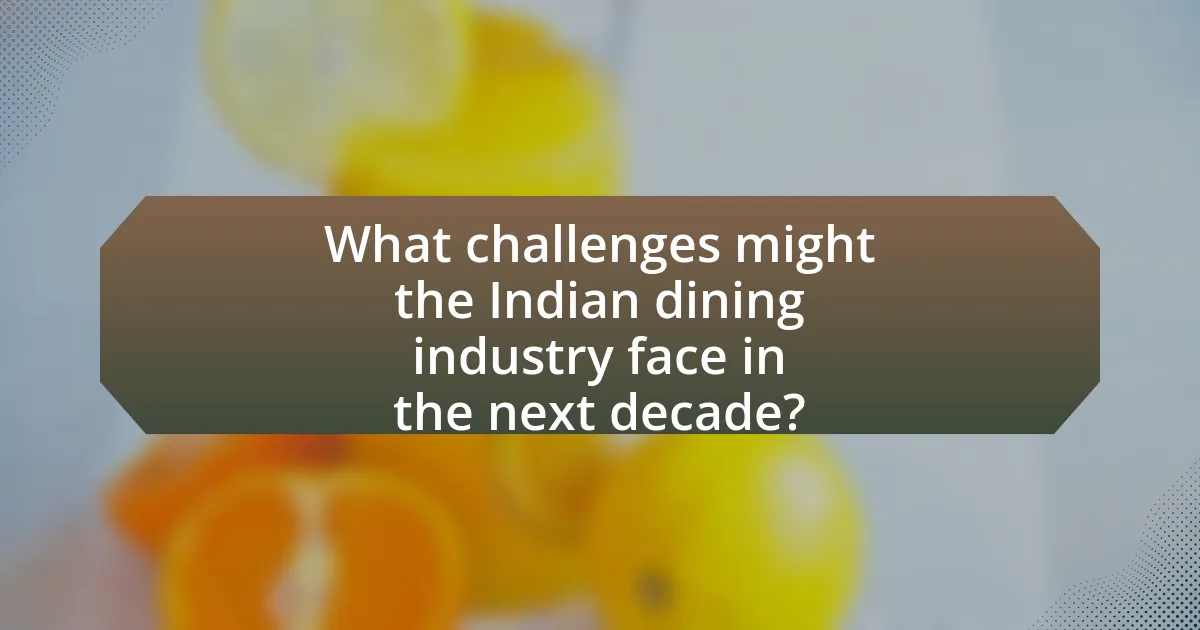The article focuses on the future of Indian dining, highlighting emerging trends expected to shape the industry over the next decade. Key trends include a significant shift towards plant-based cuisine driven by health and sustainability concerns, the integration of technology in food delivery and reservations, and an emphasis on local sourcing and eco-friendly practices. Additionally, the article discusses how consumer preferences are evolving towards healthier and more sustainable options, the impact of digital payments, and the challenges the industry may face, such as rising food costs and regulatory changes. Overall, it provides a comprehensive overview of the innovations and adaptations necessary for restaurants to thrive in a changing dining landscape.

What are the emerging trends in Indian dining for the next decade?
Emerging trends in Indian dining for the next decade include a significant shift towards plant-based cuisine, increased use of technology for food delivery and reservations, and a growing emphasis on sustainability. The plant-based trend is driven by health-conscious consumers and environmental concerns, with a report from the Good Food Institute indicating a 300% increase in plant-based food sales in India from 2019 to 2021. Technology integration is evident as restaurants adopt apps and AI for enhanced customer experiences, with a survey by Zomato showing that 70% of diners prefer online ordering. Sustainability is becoming crucial, with many establishments focusing on locally sourced ingredients and eco-friendly practices, reflecting a broader global movement towards responsible dining.
How is technology shaping the future of Indian dining?
Technology is significantly shaping the future of Indian dining by enhancing convenience, personalization, and efficiency. The rise of food delivery apps like Zomato and Swiggy has transformed how consumers access meals, allowing them to order from a wide variety of restaurants with just a few taps on their smartphones. Additionally, advancements in artificial intelligence and machine learning are enabling restaurants to analyze customer preferences and tailor menus accordingly, improving customer satisfaction. For instance, data from a 2022 report by Statista indicates that the online food delivery market in India is projected to reach $12 billion by 2025, highlighting the growing reliance on technology in dining experiences. Furthermore, the integration of contactless payment systems and digital menus has streamlined the dining process, making it safer and more efficient, especially in the wake of the COVID-19 pandemic.
What role do food delivery apps play in this transformation?
Food delivery apps significantly enhance the transformation of Indian dining by providing convenience, accessibility, and a diverse range of culinary options. These platforms enable consumers to order food from various restaurants with just a few taps on their smartphones, thus catering to the growing demand for on-demand services. According to a report by Statista, the Indian online food delivery market is projected to reach $12 billion by 2025, indicating a substantial shift in consumer behavior towards digital dining solutions. This trend reflects a broader transformation in the food industry, where traditional dining experiences are increasingly supplemented by technology-driven services that prioritize customer convenience and choice.
How is digital payment influencing dining experiences?
Digital payment is significantly enhancing dining experiences by streamlining transactions and improving customer convenience. With the adoption of mobile wallets and contactless payment methods, diners can complete their payments quickly, reducing wait times and enhancing overall satisfaction. According to a report by the National Restaurant Association, 60% of consumers prefer to pay digitally, indicating a strong preference for these methods. Additionally, digital payments facilitate better tracking of spending habits, allowing restaurants to tailor their offerings and promotions to customer preferences, thereby creating a more personalized dining experience.
What changes are occurring in consumer preferences?
Consumer preferences are shifting towards healthier, sustainable, and locally sourced food options in the Indian dining sector. This change is driven by increased awareness of health issues, environmental concerns, and a desire for authenticity in cuisine. According to a survey by the National Restaurant Association of India, 70% of consumers now prioritize health-conscious choices when dining out, reflecting a significant trend towards plant-based diets and organic ingredients. Additionally, 60% of respondents express a preference for restaurants that support local farmers and sustainable practices, indicating a growing demand for transparency in food sourcing.
How is health consciousness affecting food choices?
Health consciousness is significantly influencing food choices by driving consumers towards healthier options, such as organic, low-calorie, and nutrient-dense foods. This shift is evidenced by a 2021 survey from the International Food Information Council, which found that 85% of consumers are more likely to choose foods that support their health goals. As a result, restaurants and food brands are increasingly offering menus that highlight health benefits, such as plant-based dishes and clean-label products, to meet the demand for nutritious meals.
What impact does sustainability have on dining trends?
Sustainability significantly influences dining trends by driving consumer preferences towards eco-friendly practices and locally sourced ingredients. As awareness of environmental issues grows, diners increasingly seek restaurants that prioritize sustainable sourcing, waste reduction, and ethical food production. For instance, a 2021 survey by the National Restaurant Association found that 70% of consumers are more likely to choose a restaurant that offers sustainable options. This shift is prompting establishments to adopt practices such as farm-to-table sourcing, plant-based menus, and reduced plastic usage, aligning with the values of a more environmentally conscious clientele.
How are cultural influences evolving in Indian dining?
Cultural influences in Indian dining are evolving through the integration of global cuisines and modern culinary techniques. This evolution is evident as traditional Indian dishes are being reinterpreted with international flavors, such as the fusion of Indian spices with Italian pasta or Mexican tacos. Additionally, the rise of health-conscious dining has led to the incorporation of organic and locally sourced ingredients, reflecting a shift towards sustainability. According to a 2022 report by the National Restaurant Association of India, 60% of consumers are now seeking healthier options, indicating a significant change in dining preferences. This blending of cultures and focus on health is reshaping the landscape of Indian dining, making it more diverse and adaptable to contemporary tastes.
What fusion cuisines are gaining popularity?
Indian-Mexican fusion cuisine is gaining popularity, characterized by dishes that blend traditional Indian flavors with Mexican ingredients and cooking techniques. This trend is evident in the rise of items like masala tacos and paneer quesadillas, which combine spices and textures from both cultures. Additionally, Indian-Italian fusion is also on the rise, with dishes such as butter chicken pasta and tikka masala pizza becoming increasingly common in urban dining scenes. These fusion cuisines reflect a growing consumer interest in innovative culinary experiences that merge diverse cultural elements.
How are traditional dining practices being modernized?
Traditional dining practices are being modernized through the integration of technology, innovative culinary techniques, and evolving consumer preferences. Restaurants are adopting digital menus and contactless payment systems to enhance convenience and safety, reflecting a shift towards a more tech-savvy dining experience. Additionally, chefs are reinterpreting traditional recipes with contemporary ingredients and presentation styles, appealing to younger generations while preserving cultural heritage. For instance, the rise of fusion cuisine combines traditional Indian flavors with global culinary trends, creating unique dining experiences that attract diverse clientele. This modernization is supported by data indicating that 70% of millennials prefer dining experiences that offer both authenticity and innovation, highlighting the demand for a blend of tradition and modernity in dining.

What innovations are expected in Indian dining establishments?
Innovations expected in Indian dining establishments include the integration of technology, such as AI-driven menu personalization and contactless dining experiences. These advancements aim to enhance customer engagement and streamline operations. For instance, restaurants are increasingly adopting mobile apps for ordering and payment, which has been shown to improve efficiency and customer satisfaction. Additionally, the use of sustainable practices, like farm-to-table sourcing and eco-friendly packaging, is gaining traction, reflecting a growing consumer preference for environmentally responsible dining options. According to a report by the National Restaurant Association of India, 70% of consumers are more likely to choose restaurants that prioritize sustainability, indicating a significant shift in dining trends.
How are restaurants adapting to new dining formats?
Restaurants are adapting to new dining formats by incorporating technology and enhancing customer experience. Many establishments are implementing online ordering systems and contactless payment options to facilitate takeout and delivery services, which have surged in popularity. According to a report by the National Restaurant Association, 60% of consumers now prefer takeout and delivery options over dining in. Additionally, restaurants are redesigning their physical spaces to accommodate social distancing, creating outdoor dining areas, and offering flexible seating arrangements. This shift not only meets health guidelines but also caters to changing consumer preferences for convenience and safety.
What is the significance of cloud kitchens in the future?
Cloud kitchens are significant for the future of dining as they optimize food delivery efficiency and reduce operational costs for restaurants. By eliminating the need for physical dining spaces, cloud kitchens allow businesses to focus on food quality and delivery logistics, catering to the growing demand for convenience in urban areas. According to a report by the National Restaurant Association of India, the cloud kitchen market is projected to grow at a CAGR of 12% over the next five years, indicating a substantial shift in consumer preferences towards online food ordering. This trend reflects the increasing reliance on technology and delivery services, positioning cloud kitchens as a pivotal component in the evolving landscape of the Indian dining experience.
How are experiential dining concepts changing the landscape?
Experiential dining concepts are transforming the landscape by prioritizing immersive experiences that engage all senses, thereby enhancing customer satisfaction and loyalty. These concepts often incorporate unique themes, interactive elements, and personalized service, which differentiate them from traditional dining. For instance, restaurants that offer cooking classes or chef’s table experiences have seen increased patronage, as evidenced by a 2019 report from the National Restaurant Association, which indicated that 60% of consumers are more likely to visit a restaurant that provides an interactive dining experience. This shift not only attracts a diverse clientele but also encourages social media sharing, further amplifying brand visibility and customer engagement.
What role does local sourcing play in future dining trends?
Local sourcing will play a crucial role in future dining trends by enhancing sustainability and supporting local economies. As consumers increasingly prioritize fresh, organic, and ethically sourced ingredients, restaurants that adopt local sourcing practices can meet this demand while reducing their carbon footprint. According to a 2021 survey by the National Restaurant Association, 70% of consumers are more likely to choose a restaurant that offers locally sourced food. This trend not only fosters community relationships but also promotes seasonal menus that reflect regional flavors, thereby enriching the dining experience.
How are restaurants promoting farm-to-table practices?
Restaurants are promoting farm-to-table practices by sourcing ingredients directly from local farms, which enhances freshness and supports regional agriculture. Many establishments are establishing partnerships with nearby farmers to ensure a steady supply of seasonal produce, thereby reducing transportation emissions and fostering community relationships. For instance, a survey by the National Restaurant Association found that 60% of consumers are more likely to visit restaurants that offer locally sourced food, indicating a growing demand for such practices. Additionally, restaurants often highlight these partnerships on their menus and websites, educating customers about the origins of their food, which further promotes transparency and sustainability in dining.
What benefits does local sourcing provide to consumers and businesses?
Local sourcing benefits consumers and businesses by enhancing product freshness and supporting local economies. Freshness is achieved as locally sourced products often have shorter transportation times, leading to better taste and nutritional value. For businesses, local sourcing fosters community relationships and can reduce supply chain costs, as evidenced by a 2018 study from the USDA, which found that local sourcing can lower transportation expenses by up to 30%. Additionally, consumers tend to prefer local products, which can increase sales for businesses and contribute to a sustainable economic model.
How is the beverage industry evolving alongside dining trends?
The beverage industry is evolving by increasingly aligning its offerings with contemporary dining trends, such as health consciousness and sustainability. For instance, the rise of plant-based diets has led to a surge in demand for non-alcoholic and low-alcohol beverages, including kombucha and craft sodas, which cater to health-focused consumers. Additionally, the trend towards sustainability has prompted beverage companies to adopt eco-friendly packaging and source ingredients responsibly, reflecting the values of environmentally conscious diners. According to a report by Mintel, 60% of consumers are more likely to choose brands that are environmentally friendly, indicating a significant shift in consumer preferences that the beverage industry is responding to.
What are the rising trends in Indian beverages?
Rising trends in Indian beverages include the increasing popularity of health-focused drinks, such as cold-pressed juices and herbal teas, as consumers prioritize wellness. Additionally, there is a notable shift towards craft beverages, including artisanal beers and locally sourced spirits, reflecting a growing interest in unique flavors and sustainable production methods. The market for non-alcoholic options is also expanding, with innovations in mocktails and functional beverages that cater to diverse dietary preferences. According to a report by Research and Markets, the Indian beverage market is projected to grow significantly, driven by these health-conscious and craft trends, indicating a shift in consumer preferences towards quality and wellness.
How are non-alcoholic options becoming more popular?
Non-alcoholic options are becoming more popular due to a growing consumer demand for healthier lifestyle choices and increased awareness of the negative effects of alcohol. This trend is evidenced by a significant rise in the market for non-alcoholic beverages, which has seen a compound annual growth rate of approximately 7.5% from 2020 to 2025, according to a report by Grand View Research. Additionally, many restaurants and bars are expanding their menus to include a variety of non-alcoholic cocktails and beverages, catering to a diverse clientele that includes health-conscious individuals and those seeking alternatives for social occasions.

What challenges might the Indian dining industry face in the next decade?
The Indian dining industry may face significant challenges in the next decade, including rising food costs, labor shortages, and increased competition from delivery services. Rising food costs are driven by inflation and supply chain disruptions, which can impact profit margins for restaurants. Labor shortages are exacerbated by changing workforce dynamics and the need for skilled staff, making it difficult for establishments to maintain service quality. Additionally, the growing popularity of food delivery services poses a competitive threat, as consumers increasingly prefer convenience over dining out, potentially leading to reduced foot traffic in traditional restaurants. These challenges necessitate strategic adaptations by industry players to remain viable and competitive.
How will economic factors influence dining trends?
Economic factors will significantly influence dining trends by shaping consumer spending habits and preferences. As disposable income fluctuates, individuals may prioritize dining out less frequently or opt for more affordable dining options. For instance, during economic downturns, data from the National Restaurant Association indicates that consumers tend to favor value-oriented meals and promotions, leading to a rise in fast-casual dining and takeout services. Conversely, in periods of economic growth, there is often an increase in demand for premium dining experiences, as consumers are willing to spend more on gourmet meals and unique culinary experiences. This correlation between economic conditions and dining choices highlights the importance of adapting restaurant offerings to align with consumer financial capabilities.
What impact does inflation have on consumer spending in dining?
Inflation negatively impacts consumer spending in dining by increasing prices, which leads to reduced discretionary spending. As food and service costs rise, consumers may opt for less expensive dining options or decrease their overall frequency of dining out. For instance, a report from the National Restaurant Association indicates that during periods of high inflation, restaurant sales often decline as consumers prioritize essential expenses over dining experiences. This trend reflects a broader economic behavior where rising costs force consumers to adjust their spending habits, ultimately affecting the dining industry’s revenue.
How are supply chain issues affecting restaurant operations?
Supply chain issues are significantly disrupting restaurant operations by causing delays in ingredient availability and increasing costs. Restaurants face challenges in sourcing essential items, leading to menu limitations and inconsistent food quality. For instance, a survey by the National Restaurant Association in 2022 indicated that 75% of restaurant operators reported supply chain disruptions affecting their ability to serve customers. This situation forces many establishments to adapt by altering menus, increasing prices, or seeking alternative suppliers, ultimately impacting customer satisfaction and profitability.
What regulatory changes could impact the dining industry?
Regulatory changes that could impact the dining industry include new health and safety regulations, changes in labor laws, and modifications to food safety standards. For instance, the implementation of stricter health codes can require restaurants to invest in better sanitation practices, which may increase operational costs. Additionally, changes in labor laws, such as minimum wage increases or new employee benefits mandates, can affect staffing budgets and operational structures. Furthermore, updates to food safety standards, such as those related to allergen labeling or sourcing of ingredients, can necessitate adjustments in menu offerings and supplier relationships. These regulatory shifts are often influenced by public health concerns and consumer demand for transparency and safety in food service.
How are health and safety regulations evolving post-pandemic?
Health and safety regulations are evolving post-pandemic by incorporating more stringent hygiene standards and contactless service protocols in the dining industry. Regulatory bodies are now mandating enhanced cleaning procedures, such as frequent sanitization of surfaces and the use of personal protective equipment by staff. For instance, the Food Safety and Standards Authority of India (FSSAI) has updated guidelines to include measures for managing food safety risks associated with COVID-19, emphasizing the importance of maintaining physical distancing and minimizing contact during food preparation and service. These changes reflect a broader trend towards prioritizing consumer safety and confidence in dining establishments, which is crucial for the industry’s recovery and future growth.
What challenges do restaurants face in compliance with new laws?
Restaurants face significant challenges in compliance with new laws, primarily due to the complexity and rapid changes in regulations. These challenges include understanding and implementing health and safety standards, labor laws, and environmental regulations, which often vary by region and can be difficult to navigate. For instance, the introduction of new food safety regulations requires restaurants to invest in training staff and updating procedures, which can strain resources. Additionally, compliance with labor laws, such as minimum wage increases and employee benefits, can lead to increased operational costs. According to a survey by the National Restaurant Association, 75% of restaurant operators reported that regulatory compliance is a major concern, highlighting the impact of these challenges on their business operations.
What strategies can restaurants adopt to thrive in the future?
Restaurants can thrive in the future by adopting a multi-faceted approach that includes enhancing digital presence, focusing on sustainability, and diversifying menu offerings. A strong digital presence, including online ordering and social media engagement, is essential as 60% of consumers prefer to order food online, according to a report by Statista. Sustainability practices, such as sourcing local ingredients and reducing waste, can attract environmentally conscious customers, with 73% of millennials willing to pay more for sustainable options, as noted by Nielsen. Additionally, diversifying menu offerings to include plant-based and health-conscious options can cater to evolving consumer preferences, supported by a 2021 survey from the Plant Based Foods Association indicating a 27% increase in plant-based food sales. These strategies collectively position restaurants to meet changing market demands and consumer expectations effectively.
How can restaurants leverage technology for better customer engagement?
Restaurants can leverage technology for better customer engagement by implementing mobile apps, online reservations, and personalized marketing strategies. Mobile apps enhance customer interaction by allowing users to place orders, make reservations, and receive loyalty rewards directly from their smartphones. Online reservation systems streamline the booking process, reducing wait times and improving customer satisfaction. Personalized marketing, driven by data analytics, enables restaurants to tailor promotions and recommendations based on individual customer preferences, leading to increased loyalty and repeat visits. According to a report by the National Restaurant Association, 70% of consumers are more likely to choose a restaurant that offers mobile ordering, highlighting the effectiveness of technology in enhancing customer engagement.
What best practices should restaurants follow to ensure sustainability?
Restaurants should implement waste reduction strategies, source local and seasonal ingredients, and adopt energy-efficient practices to ensure sustainability. Waste reduction can be achieved through composting, recycling, and minimizing food waste, which not only lowers disposal costs but also reduces environmental impact. Sourcing local and seasonal ingredients supports local economies and decreases carbon footprints associated with transportation. Energy-efficient practices, such as using LED lighting and energy-efficient appliances, can significantly lower energy consumption, contributing to overall sustainability. According to the Food Waste Reduction Toolkit by the USDA, reducing food waste can save restaurants up to $1,500 per year for every 1% of waste reduced, highlighting the financial benefits of these practices.
